Meningioma
An 85-year-old male patient, medically free, complaining of a fall with trauma to right side of the head, and complaining of heavy tongue and right-sided weakness.
CLINICAL HISTORY
An 85-year-old male patient, medically free, complaining of a fall with trauma to right side of the head, and complaining of heavy tongue and right-sided weakness.
CT FINDING
Contrast was given after review of initial precontrast scan as it shows mass unrelated to trauma.
CT shows small focus of acute bleed in right frontal lobe.
Enhancing mass lesion of about 4.0 x 3.9 x 3.9cm in left frontoparital region have broad dural base over innertable with hyperosteosis. Surrounding edema and causes mild midline shift to the right side, consistent with hemangioma.
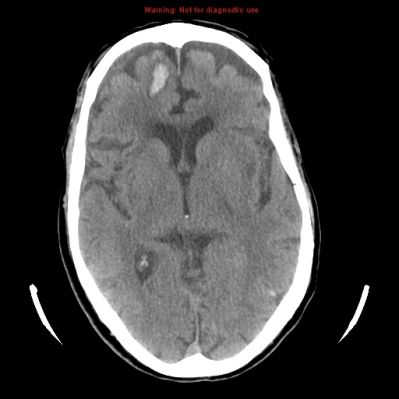
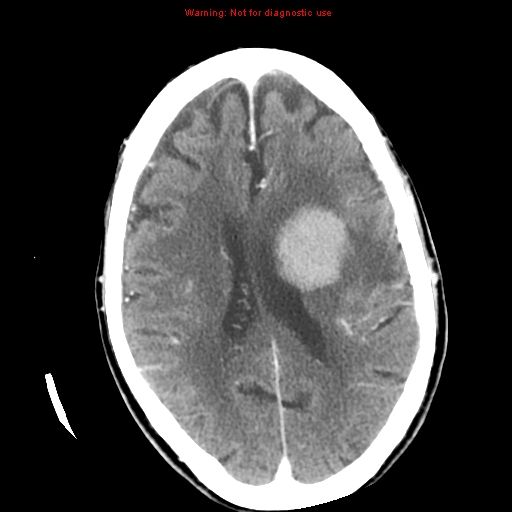
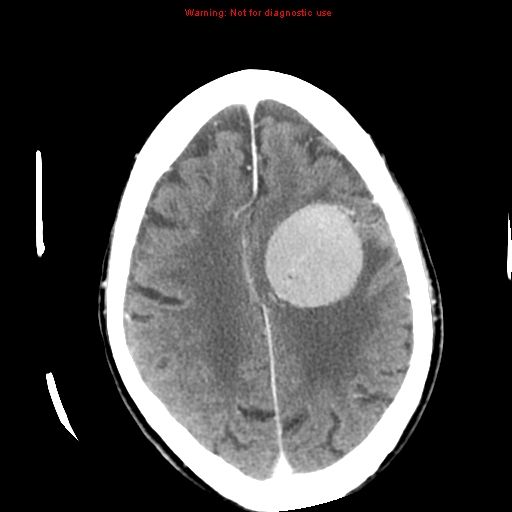
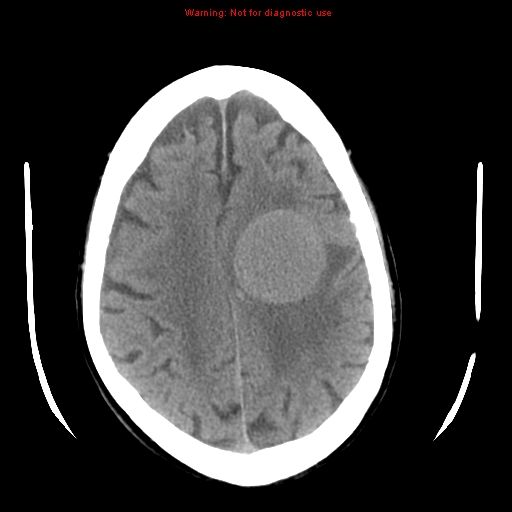
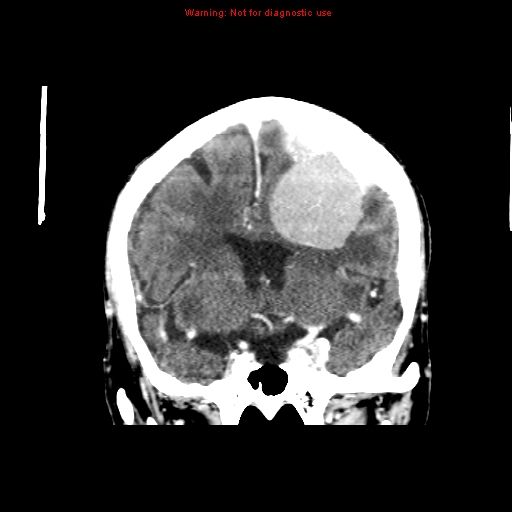
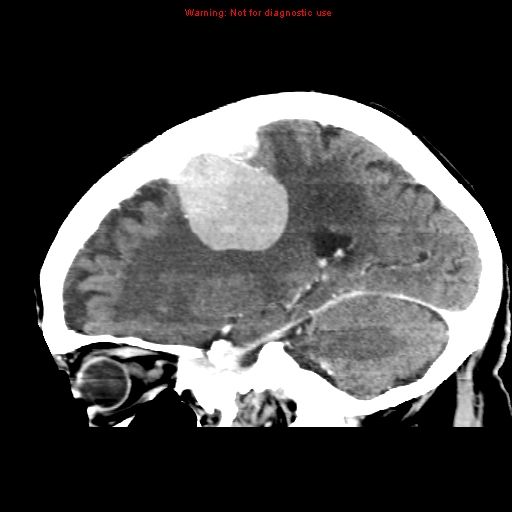
MENINGIOMAS
Meningiomas are the second most common primary neoplasm of the central nervous system, arising from the arachnoid "cap" cells of the arachnoid villi in the meninges. These tumors are usually benign in nature; however, they can be malignant. Meningiomas may occur intracranially or within the spinal canal.
Meningiomas commonly are found at the surface of the brain, either over the convexity or at the skull base. In rare cases, meningiomas occur in an intraventricular or intraosseous location. The problem of classifying meningioma is that arachnoidal cells may express both mesenchymal and epithelial characteristics. Other mesodermal structures also may give rise to similar tumors (eg, hemangiopericytomas or sarcomas). The classification of all of these tumors together is controversial. The current trend is to separate unequivocal meningiomas from other less well-defined neoplasms. Undoubtedly, advances in molecular biology will allow scientists to determine the exact genomic aberration responsible for each specific neoplasm.
Mortality/Morbidity
Mortality and morbidity rates for meningiomas are difficult to assess. Some meningiomas are discovered fortuitously when CT or MRI is done to assess for unrelated diseases or conditions. Therefore, some patients die with meningioma and not from it. Estimates of the five-year survival usually range from 73 percent to 94 percent.
A systematic review of the literature regarding the clinical behavior of small, untreated meningiomas suggests that most meningiomas 2.5 cm or less in diameter do not proceed to cause symptoms in the five years following their discovery. Patients with tumors 2.5 to 3 cm in initial size went on to develop new or worsened symptoms 17 percent of the time. Those that do cause symptoms can usually be predicted with close radiographic follow-up.
Meningiomas usually grow slowly, and they may produce severe morbidity before causing death.
Factors that may be predictive of a high postoperative morbidity rate include patient-related factors (eg, advanced age, comorbid states such as diabetes or coronary artery disease, preoperative neurological status), tumor factors (eg, location, size, consistency, vascularity, vascular or neural involvement), previous surgery, or previous radiation therapy.
Race and Sex
Meningiomas are more prevalent in Africa than in North America or Europe. In Los Angeles County, meningioma is reported more commonly in African Americans than in others. Meningiomas afflict women more often than men. The male-to-female ratio ranges from 1:1.4 to 1:2.8. The female preponderance may be less pronounced in the black population than in other groups. Meningiomas are equally distributed between boys and girls.
History
Meningiomas produce their symptoms by several mechanisms. They may cause symptoms by irritating the underlying cortex, compressing the brain or the cranial nerves, producing hyperostosis and/or invading the overlying soft tissues, or inducing vascular injuries to the brain.
The signs and symptoms secondary to meningiomas may appear or become exacerbated during pregnancy but usually abate or improve in the postpartum period.
• Irritation: By irritating the underlying cortex, meningiomas can cause seizures. New-onset seizures in adults justify neuroimaging (eg, MRI) to exclude the possibility of an intracranial neoplasm.
• Compression: Localized or nonspecific headaches are common. Compression of the underlying brain can give rise to focal or more generalized cerebral dysfunction, as evinced by focal weakness, dysphasia, apathy, and/or somnolence.
• Stereotypic symptoms: Meningiomas in specific locations may give rise to the stereotyped symptoms listed in the Table. These stereotypical symptoms are not pathognomonic of meningiomas in these locations; they may occur with other conditions or lesions. Conversely, meningiomas in these locations may remain asymptomatic or produce other unlisted symptoms.
Symptoms and Signs Associated with Meningiomas in Specific Locations
Paraparesis, sphincteric troubles, tongue atrophy associated with fasciculation
• Vascular: This presentation, although rare, should be considered. Meningiomas of the skull base may narrow and even occlude important cerebral arteries, possibly presenting either as transient ischemic attack (TIA)–like episodes or as stroke.
• Miscellaneous
o Intraventricular meningiomas may present with obstructive hydrocephalus.
o Meningiomas in the vicinity of the sella turcica may produce panhypopituitarism.
o Meningiomas that compress the visual pathways produce various visual field defects, depending on their location.
o Rarely, chordoid meningiomas can present with hematologic disturbances, namely Castleman syndrome.
Physical Examination
The physical findings mirror the aforementioned symptoms and include signs due to raised intracranial pressure, involvement of cranial nerves, compression of the underlying parenchyma, and involvement of bone and subcutaneous tissues by the meningioma.
• Raised intracranial pressure leads to papilledema, decreased mentation and, ultimately, to brain herniation.
• Involvement of the cranial nerves may lead to anosmia, visual field defects, optic atrophy, diplopia, decreased facial sensation, facial paresis, decreased hearing, deviation of the uvula, and hemiatrophy of the tongue.
• Compression of the underlying parenchyma may give rise to pyramidal signs that are exemplified by pronator drift, hyperreflexia, positive Hoffman sign, and presence of the Babinski sign. Parietal-lobe syndrome may occur if the parietal lobes are compressed.
o Compression of the dominant (usually left) parietal lobe may give rise to Gerstmann syndrome: agraphia, acalculia, right-left disorientation, and finger agnosia.
o Compression of the nondominant (usually right) parietal lobe leads to tactile and visual extinction and neglect of the contralateral side.
o Compression of the occipital lobes leads to a congruent homonymous hemianopsia.
• Spinal meningiomas may give rise to a Brown-Sequard syndrome (ie, contralateral decreased pain sensation, ipsilateral weakness, decrease in position sense), sphincteric weakness and, ultimately, complete quadriparesis or paraparesis.
Differentials
• Brainstem Gliomas
• Cavernous Sinus Syndromes
• Complex Partial Seizures
• Craniopharyngioma
• Frontal Lobe Syndromes
• Glioblastoma Multiforme
• Low-Grade Astrocytoma
• Neurofibromatosis, Type 1
• Neurofibromatosis, Type 2
• Oligodendroglioma
• Persistent Idiopathic Facial Pain
• Pituitary Tumors
• Primary CNS Lymphoma
Imaging Studies
• Imaging studies are the mainstay of diagnosis. See images below for representative radiologic views of various subtypes.
• Plain skull radiograph may reveal hyperostosis and increased vascular markings of the skull, as well as intracranial calcifications.
• On plain head CT scans, meningiomas are usually dural-based tumors that are isoattenuating to slightly hyperattenuating.
o They enhance homogeneously and intensely after the injection of iodinated contrast material.
o Perilesional edema may be extensive. Hyperostosis and intratumoral calcifications may be present.
o The tumor compresses the brain without invading it.
o Multiple meningiomas may be difficult to differentiate from metastasis.
• On T1- and T2-weighted MRIs, the tumors have variable signal intensity. If a meningioma is suspected, obtaining an enhanced MRI is imperative.
o Meningiomas enhance intensely and homogeneously after injection of gadolinium gadopentetate.
o The edema may be more apparent on MRI than on CT scanning.
o An enhancing tail involving the dura may be apparent on MRI.
o Cystic meningiomas may exhibit intratumoral or peritumoral cysts. The peritumoral cysts may actually represent a gliotic response and may not necessitate surgical extirpation.
• Endovascular angiography allows the surgeon to preoperatively determine the vascularization of the tumor and its encroachment on vital vascular structures.
o Late venous images are important to determine the patency of the involved dural sinuses.
o Angiographic features of meningiomas include the following:
- Supply from the external circulation
- Mother-in-law blush (which comes early and leaves late)
- Sunburst or radial appearance of the feeding arteries
o Although magnetic resonance arteriography (MRA) and magnetic resonance venography (MRV) have decreased the role of classical angiography, the latter remains a powerful tool for planning surgery.
o Angiography is still indispensable if embolization of the tumor is deemed necessary.
• New research tools such as positron emission tomography (PET), including octreotide-PET, or magnetic resonance spectroscopy (MRS) have been used to predict in vivo the aggressiveness of meningiomas.
Treatment
Observation with close imaging follow-up can be used in select cases if a meningioma is small and asymptomatic. Observation is not recommended in tumors already causing symptoms. Furthermore, close follow-up with imaging is required with an observation strategy to rule out an enlarging tumor.
Meningiomas can usually be surgically resected with permanent cure if the tumor is superficial on the dural surface and easily accessible. Transarterial embolization has become a standard preoperative procedure in the preoperative management. If invasion of the adjacent bone occurs, total removal is nearly impossible. Malignant transformation is rare.
The probability of tumor recurrence or growth after surgical resection can be estimated by the tumor's WHO Grade and by the extent of surgery by the Simpson Criteria.
10-year Recurrence
• Stereotactic radiosurgery has been shown to provide excellent local tumor control with minimal toxicity.
o It is mainly used for small (< 3 cm in diameter) residual or recurrent lesions when surgery is considered to carry a significantly high risk of morbidity.
o It has been advocated as an effective management strategy for small meningiomas and for meningiomas involving the skull base or the cavernous sinus.
o It is used primarily to prevent tumor progression.
Radiation therapy may include photon beam or proton beam treatment, or fractionated external beam radiation. Radiosurgery can be used in lieu of surgery in small tumors located away from critical structures. Fractionated external beam radiation can also be used as primary treatment for tumors that are surgically unresectable, or for patients who are inoperable for medical reasons.
Radiation therapy is often considered for WHO Grade I meningiomas after subtotal (incomplete) tumor resections. The clinical decision to irradiate after a subtotal resection is somewhat controversial, as no class I randomized controlled trials exist on the subject. Numerous retrospective studies, however, have strongly suggested the addition of postoperative radiation to incomplete resections improves both progression free survival (i.e. prevents tumor recurrence) and improves overall survival.
In the case of a Grade II or Grade III meningioma, the current standard of care involves postoperative radiation treatment regardless of the degree of surgical resection. This is due to the proportionally higher rate of local recurrence for these higher grade tumors.
Current chemotherapies are likely not effective. Antiprogestin agents have been used, but with variable results. Recent evidence that hydroxyurea has the capacity to shrink unresectable or recurrent meningiomas is being further evaluated.
Sushila Ladumor, MD, FRCR, Consultant Radiologist with Multi-modality Imaging experience, working in Medical Imaging Department, King Abdulaziz Medical City, Riyadh, Saudi Arabia.
REFERENCES
1. "The meningiomas (dural endotheliomas): their source, and favoured seats of origin.". Brain (45). 1922. http://www.medmerits.com/index.php/article/meningiomas/P1.
2. Buetow MP, Buetow PC, Smirniotopoulos JG (November 1991). "Typical, atypical, and misleading features in meningioma". Radiographics 11 (6): 1087–106. PMID 1749851. http://radiographics.rsnajnls.org/cgi/pmidlookup?view=long&pmid=1749851. Retrieved 2008-12-01.
3. Goldsmith BJ, Wara WM, Wilson CB, Larson DA (February 1994). "Postoperative irradiation for subtotally resected meningiomas. A retrospective analysis of 140 patients treated from 1967 to 1990". J. Neurosurg. 80 (2): 195–201. doi:10.3171/jns.1994.80.2.0195. PMID 8283256.
4. emedicine.medscape.com/article/1156552-overview
Clarius Mobile Health Unveils Anterior Knee Feature for Handheld Ultrasound
April 23rd 2025The T-Mode Anterior Knee feature reportedly offers a combination of automated segmentation and real-time conversion of grayscale ultrasound images into color-coded visuals that bolster understanding for novice ultrasound users.
The Reading Room Podcast: Current Perspectives on the Updated Appropriate Use Criteria for Brain PET
March 18th 2025In a new podcast, Satoshi Minoshima, M.D., Ph.D., and James Williams, Ph.D., share their insights on the recently updated appropriate use criteria for amyloid PET and tau PET in patients with mild cognitive impairment.
What is the Best Use of AI in CT Lung Cancer Screening?
April 18th 2025In comparison to radiologist assessment, the use of AI to pre-screen patients with low-dose CT lung cancer screening provided a 12 percent reduction in mean interpretation time with a slight increase in specificity and a slight decrease in the recall rate, according to new research.